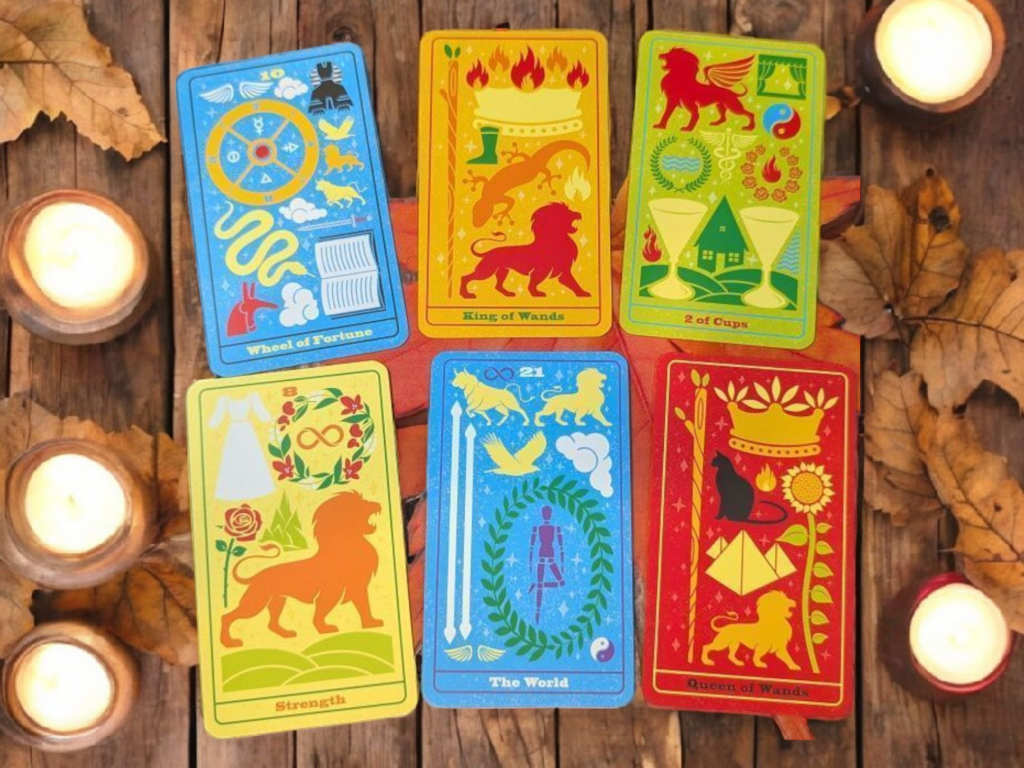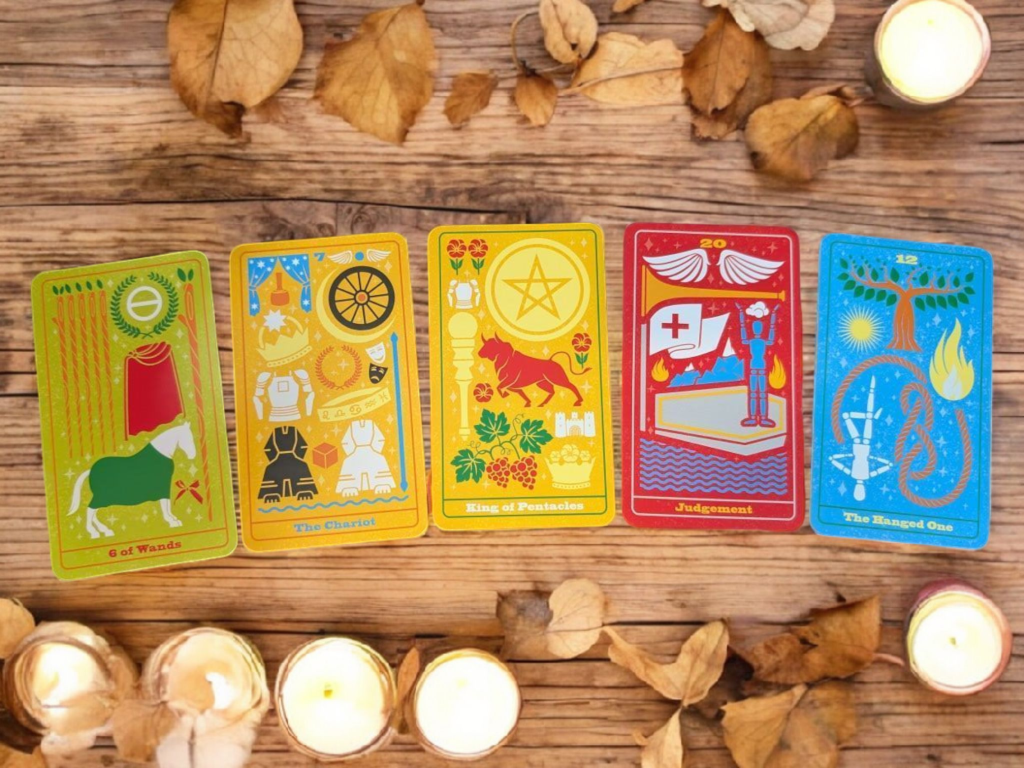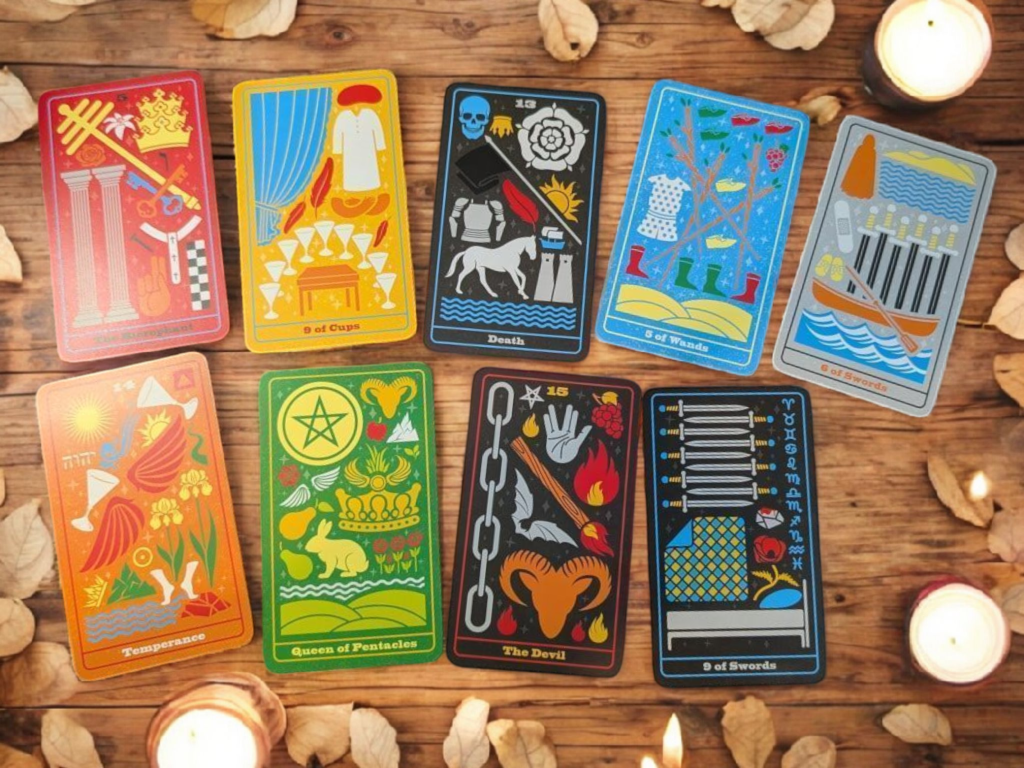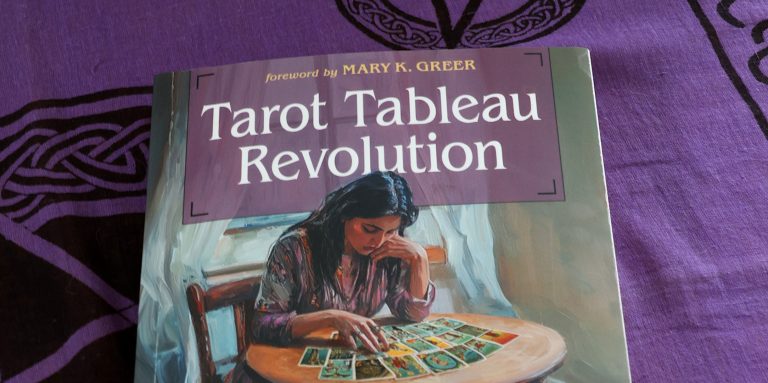- Deck Title: Tarot Disassembled (deck & separate guidebook)
- Author & Artist: Jennifer Cooper Steidley
- Publisher: Weiser Books
- Published: April-2025 (USA)
- RRP – Deck: US $24.95 / GB £23.99 (deck)
- RRP – Book: US $18.95 / GB £16.99 (book)
- ISBN: 978‐1578638659
- Reviewed by: May M.F. Swann (@intuitionwizard)
Jennifer Cooper Steidley is my kind of people: deeply in love with symbols and design, a deck collector and self-proclaimed research nerd. Perfect for the likes of the Intuition Wizard! Her joy lies in deep dives and big questions, and what better way to explore tarot than by extracting all its symbolism into distinct parts that can be studied, dissected, and understood in new ways?
Tarot Disassembled is a love letter to that process: peeling back the layers of traditional imagery to get at the bones beneath. Jennifer’s dedication to research and structure is clear throughout. Even the guidebook includes a (brief but welcome) history of tarot, hinting at the scholarly mind behind the art!

Tarot Disassembled is, as the name suggests, a reinterpretation of the Rider Waite Smith deck in which the author has broken each card down to its symbolic components. Gone is the narrative and figurative storytelling; what remains is a raw, clean focus on the symbols themselves, extracted from the original scenes and laid out like puzzle pieces to be studied in their own right.

As the guidebook explains, the goal is “to deconstruct the traditional symbolism found in the RWS deck and strive to uncover deeper meaning within the individual symbols.” The process is like peeling the symbols like onions, removing the image’s narrative skin to expose the symbolic flesh beneath. Each card is no longer a singular image, but a curated collection of symbols that recur across the Arcana. This invites the reader to compare, dissect and contemplate the visual language of tarot itself, literally dissecting each card.
The deck is digitally designed using vector imagery: bold, simple and striking. The clean lines and minimalist backgrounds allow the symbols to take centre stage, free from distraction. The recurring motifs become a visual thread, helping the reader connect symbolic patterns across the entire deck.
To gain a deeper understanding of the Tarot Disassembled deck beyond first impressions, I conducted a structured five-card interview. The spread was designed to reveal the spirit and structure of the deck. I asked:
What is your core intention? – 6 of Wands
All the symbols in the Six of Wands point toward a hard-earned victory. This suggests that the deck’s core intention is to support the reader in overcoming difficulties in understanding tarot symbolism. It doesn’t hand over easy answers. Instead, it encourages the reader to engage in focused study of each individual symbol. The goal is mastery through effort. Victory is possible, yes, but it is not granted magically. The deck facilitates the path, but it is the reader who must do the work.
Where do you shine brightest? – The Chariot
The symbols in the Chariot card speak of protection, command and movement. This suggests that the deck shines brightest when used with clear intention, focus and a determined goal in mind. It is a deck designed to help you move forward, not to leave you stuck behind. Don’t let yourself be intimidated by the sheer number of symbols on each card. Tackle them one by one and understanding shall be yours.
Where do you resist or limit? – King of Pentacles
This card presents symbols similar to those in the Chariot. The armour and crown appear in both, but in the King of Pentacles, it feels as though he has already achieved everything the Chariot is striving for. The bull in the card also suggests a sense of stubbornness. This points to the deck’s limitations: it may not serve a reader who believes they already know everything. This is a deck that thrives on curiosity, not certainty. It is not here to reinforce what you already know about tarot, but to question it, update it and add new layers of understanding. I would also say this deck is not ideal for purely intuitive or psychic readings. Like the King of Pentacles, it is grounded in the material. It asks for study, not surrender.
How should a reader work with you? – Judgement
The symbols in this card reinforce the idea that this deck should be used to transform the way you see the tarot cards. It’s a call to action for the reader to put to rest what they thought they knew and open themselves to the new understanding this deck can bring.
What should your relationship with the reader be like? – The Hanged One
This card suggests that the deck’s relationship with the reader will be one that may feel uncomfortable at times but will ultimately lead to new understanding and a shift in perspective. Alongside the upside down figure, a symbol of waiting, limbo, unification and insight, we see a great fire burning beneath a tree. Fire brings energy, desire and transformation. The tree speaks of growth, potential and time. This relationship will challenge the reader to see things differently and unlock their full potential, but it won’t happen instantly. It will require patience, effort and a willingness to sit in the unknown.
The cards are clearly very well-thought-out and carefully constructed. They isolate the main symbols present in each individual RWS card and present them without distraction. These symbols appear in different sizes, presumably to suggest their importance or influence on the overall meaning, and while their design may vary slightly, their core identity remains the same. This makes the deck a very faithful representation of the RWS system, staying true to the specific symbolic language of that tradition.
The deck does read a little cold or analytical, as it removes the usual storytelling elements found in traditional tarot imagery. Instead, it presents a stripped back, almost black and white depiction of each card’s meaning. While this may feel more intellectual than intuitive, it offers a clear and direct reading style. The imagery keeps the reader focused, without allowing the imagination to wander too far from the core message.
The guidebook is a treat. It not only brings up the aforementioned (brief) history of the tarot, but it also proposes exercises, alongside some basic spreads. This is something rarely seen in guidebooks, and a very welcome addition. The exercises help the reader interact with the deck in a more active and reflective way, going beyond just reading card meanings.
Each card is explained in detail with a black and white picture of the card, keywords, associations, and a detailed description of each symbol, including keywords and a written explanation of what it represents in the context of the card. It also adds quick takes and reversals to each card description.
At the back of the guidebook, one can find an index of the symbols and the pages they appear on, which makes it a useful reference as well as a learning tool.
The card stock is also a delight. The matte finish gives a different feel compared to the many glossy decks out there, offering a more grounded, tactile experience. The cards slide beautifully together, making shuffling a pleasure. They are large enough to show detail clearly, but not so large that they become difficult to handle. The card stock is of very good quality, flexible enough to bend with ease but sturdy enough to return to its original shape without damage.
The backs are fully reversible so readers who work with reversals won’t be able to tell card orientation from the back. The deck comes in a sturdy two piece box that fits the cards well and opens and closes easily, practical and protective without being overly bulky.
I absolutely love this deck. I had my eye on it for a while but wondered if it was as good as it seemed. It is. Tarot Disassembled is a brilliant deck for study and for deepening your understanding of tarot, whether you are a beginner, an intermediate reader or someone who has been reading for over thirty years.
That said, I wouldn’t personally use this deck for regular readings. The disassembly of symbols makes it harder to identify cards at a glance, and it also removes some of the emotional resonance that is often vital in a reading. When reading for a querent, especially on sensitive or deeply personal matters, it is important to use a deck that can offer warmth and support as well as clarity. Our souls are not black and white, and neither should a tarot reading be.
However, for study, analysis, or situations that require a clear head and a straightforward view, this deck may bring benefits others will not.
Tarot Disassembled deck and guidebook can be purchased direct from Red Wheel Weiser
And from all good online bookstores.







0 Comments